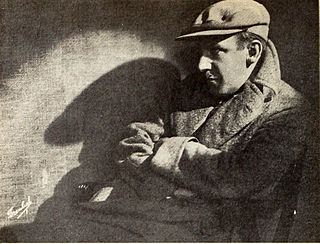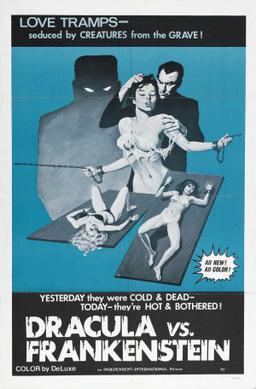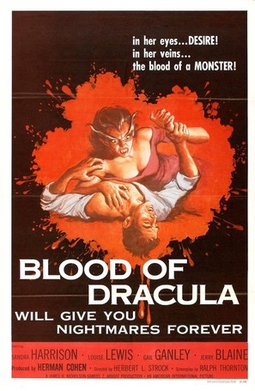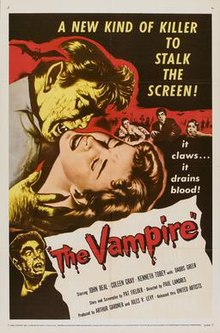
Tod Browning was an American film director, film actor, screenwriter, vaudeville performer, and carnival sideshow and circus entertainer. He directed a number of films of various genres between 1915 and 1939, but was primarily known for horror films. Browning was often cited in the trade press as "the Edgar Allan Poe of cinema."

Frankenstein is a 1931 American pre-Code science fiction horror film directed by James Whale, produced by Carl Laemmle Jr., and adapted from a 1927 play by Peggy Webling, which in turn was based on Mary Shelley's 1818 novel Frankenstein; or, The Modern Prometheus. The Webling play was adapted by John L. Balderston and the screenplay written by Francis Edward Faragoh and Garrett Fort, with uncredited contributions from Robert Florey and John Russell.
Hammer Film Productions Ltd. is a British film production company based in London. Founded in 1934, the company is best known for a series of Gothic horror and fantasy films made from the mid-1950s until the 1970s. Many of these involve classic horror characters such as Baron Victor Frankenstein, Count Dracula, and the Mummy, which Hammer reintroduced to audiences by filming them in vivid colour for the first time. Hammer also produced science fiction, thrillers, film noir and comedies, as well as, in later years, television series.

Bram Stoker's Dracula is a 1992 American gothic horror film produced and directed by Francis Ford Coppola and written by James V. Hart, based on the 1897 novel Dracula by Bram Stoker. The film stars Gary Oldman, Winona Ryder, Anthony Hopkins, Keanu Reeves, Richard E. Grant, Cary Elwes, Billy Campbell, Sadie Frost, and Tom Waits. Set in 19th-century England and Romania, it follows the titular vampire (Oldman), who falls in love with Mina Murray (Ryder), the fiancée of his solicitor Jonathan Harker (Reeves). When Dracula begins terrorizing Mina's friends, Professor Abraham Van Helsing (Hopkins), an expert in vampirism, is summoned to bring an end to his reign of terror. Its closing credits theme "Love Song for a Vampire", is written and performed by Annie Lennox.

Van Helsing is a 2004 action horror film written and directed by Stephen Sommers. It stars Hugh Jackman as monster hunter Van Helsing and Kate Beckinsale as Anna Valerious. Van Helsing is both an homage and tribute to the Universal Horror Monster films from the 1930s and 1940s, of which Sommers is a fan.

Dracula is a 1931 American pre-Code supernatural horror film directed and co-produced by Tod Browning from a screenplay written by Garrett Fort and starring Bela Lugosi in the title role. It is based on the 1924 stage play Dracula by Hamilton Deane and John L. Balderston, which in turn is adapted from the 1897 novel Dracula by Bram Stoker. Lugosi portrays Count Dracula, a vampire who emigrates from Transylvania to England and preys upon the blood of living victims, including a young man's fiancée.

Dracula's Daughter is a 1936 American vampire horror film produced by Universal Pictures as a sequel to the 1931 film Dracula. Directed by Lambert Hillyer from a screenplay by Garrett Fort, the film stars Otto Kruger, Gloria Holden in the title role, and Marguerite Churchill, and features, as the only cast member to return from the original, Edward Van Sloan – although his character's name was altered from "Van Helsing" to "Von Helsing".

Son of Dracula is a 1943 American horror film directed by Robert Siodmak with a screenplay based on an original story by his brother Curt Siodmak. The film stars Lon Chaney Jr., Louise Allbritton, Robert Paige, Evelyn Ankers, and Frank Craven. The film is set in the United States, where Count Alucard has just taken up residence. Katherine Caldwell (Allbritton), a student of the occult, becomes fascinated by Alucard and eventually marries him. Katherine begins to look and act strangely, leading her former romantic partner Frank Stanley (Paige) to suspect that something has happened to her. He gets help from Dr. Brewster (Craven) and psychologist Laszlo who come to the conclusion that Alucard is a vampire.

House of Frankenstein is a 1944 American horror film starring Boris Karloff, Lon Chaney Jr. and John Carradine. It was directed by Erle C. Kenton and produced by Universal Pictures. Based on Curt Siodmak's story "The Devil's Brood", the film is about Dr. Gustav Niemann, who escapes from prison and promises to create a new body for his assistant Daniel. Over the course of the film, they encounter Count Dracula, the Wolf Man and Frankenstein's monster. The film is a sequel to Frankenstein Meets the Wolf Man (1943).

House of Dracula is a 1945 American horror film released and distributed by Universal Pictures. Directed by Erle C. Kenton, the film features several Universal Horror properties meeting as they had done in the 1944 film House of Frankenstein. The film is set at the castle home of Dr. Franz Edelmann, who is visited first by Count Dracula and later by Larry Talbot, the Wolf Man, who are trying to cure their vampirism and lycanthropy, respectively. Talbot is eventually cured, which leads him to discover the body of Frankenstein's monster in a cave below the base of the castle. Edelemann takes the monster's body back to his laboratory but finds Count Dracula has awakened and by attacking his assistants, he captures Edelmann and forces a reverse blood transfusion, which gives Edelmann a split personality and makes him a killer.

Blood of the Vampire is a 1958 British colour horror film directed by Henry Cass and starring Donald Wolfit, Barbara Shelley, and Vincent Ball. The film was produced by Robert S. Baker and Monty Berman for Tempean Films, from a screenplay by Jimmy Sangster.

Creature Features is a program of horror shows broadcast on local American television stations throughout the 1960s, 1970s, and 1980s. The movies broadcast on these shows were generally classic and cult horror movies of the 1930s to 1950s, the horror and science-fiction films of the 1950s, British horror films of the 1960s, and the Japanese kaiju "giant monster" movies of the 1950s to 1970s.

Dracula vs. Frankenstein, released in the UK as Blood of Frankenstein, is a 1971 American science fiction horror film directed and co-produced by Al Adamson. The film stars J. Carrol Naish as Dr. Durea, a descendant of Dr. Frankenstein who is working on a blood serum with his assistant Groton. The serum soon becomes sought after by Count Dracula, who hopes that it will grant him the ability to be exposed to sunlight without harm. Other members of the film's cast include Anthony Eisley, Regina Carrol, Angelo Rossitto and Russ Tamblyn.
El vampiro is a 1957 Mexican horror film, produced by Abel Salazar and directed by Fernando Méndez from an original screenplay by Ramon Obon, and starring German Robles as Count Lavud, the vampire, Abel Salazar as Dr. Enrique, and Ariadna Welter as Marta. The film, which took influence from the canon of Universal horror, is seen as the beginning of the Mexican horror boom of the 1960s.

Rebekah Isabelle Laemmle, known professionally as Carla Laemmle, was an American actress and dancer, and the niece of Universal Pictures studio founder Carl Laemmle. As an actress/dancer, she is known primarily for her roles in The Phantom of the Opera (1925) and Dracula (1931). At the time of her death, she was one of the last surviving actors of the silent film era, with her career spanning nearly 90 years, also with one of the longest gaps.

The Return of Dracula is a 1958 American horror film directed by Paul Landres, and starring Francis Lederer, Norma Eberhardt, and Ray Stricklyn. It follows Dracula, who murders an artist aboard a train in Central Europe, and proceeds to impersonate the man, traveling to meet with his extended family in a small California town. The film is primarily in black and white, aside from one brief color sequence.
Paul Landres was an American film and television editor and director. He directed episodes of The Lone Ranger, Maverick and Flipper, among many other TV series.

Blood of Dracula is a 1957 American black-and-white horror film directed by Herbert L. Strock, and starring Sandra Harrison, Louise Lewis and Gail Ganley. It was co-written by Aben Kandel and Herman Cohen.
Dracula is a film series of horror films from Universal Pictures based on the 1897 novel Dracula by Bram Stoker and its 1927 play adaptation. Film historians had various interpretations of what constitutes being in the film series, with academics and historians finding narrative continuation between Dracula (1931) and Dracula's Daughter (1936) with varying different opinions on if Son of Dracula (1943), House of Frankenstein (1944) and House of Dracula (1945) were part of the series. Author and academic Gary Don Rhodes stated the all the mentioned films would require an audience to be familiar with Count Dracula portrayed by Bela Lugosi and the various character traits the actor established in the original 1931 film.
Pat Fielder was an American screenwriter known for penning cult B monster movies like The Return of Dracula in the 1950s. For TV, she worked on everything from Baretta to The Rifleman to Starsky & Hutch.















